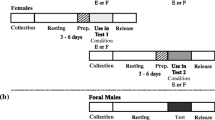Abstract
Male’s copulation investment, including spermatophore and sperm investment were very high in the Chinese bushcricket Gampsocleis gratiosa. The effects of mating status of both males and females on male’s copulation investment were examined in this study. The fresh weight of spermatophylax increased positively with the weight of males’ body. This indicated that the nutritional investment during copulation depended on male’s quality. Spermatophore investment showed insignificant differences in every copulation protocols. This finding supported the paternal investment hypothesis, that is, males contributed to their offspring with little attention to their partners. Sperm releasing per ejaculation varied significantly among the trials. Males decreased 54.19% sperm in second mating than in its first mating, demonsrated that males regarded the first mating highly, and were more prudent in subsequent mating. These males’ strategies may contribute to the viability of the offspring.
Similar content being viewed by others
References
Thornhill R. Sexual selection and paternal investment in insects. Am Nat, 1976, 110: 153–163
Zeh D W, Smith R L. Paternal investment by terrestrial arthropods. Am Zool, 1985, 25: 785–805
Gwynne D T. Male mating effort, confidence of paternity, and insect sperm competition. In: Smith R L, ed. Sperm Competition and the Evolution of Animal Mating Systems. London: Academic Press, 1984. 117–149
Simmons L W, Graig M, Llorens T, Schinzig M, Hosken D. Bushcricket spermatophores vary in accord with sperm competition and parental investment theory. Proc R Soc Lond B, 1993, 251: 183–186
Wedell N. Sperm protection and mate assessment in the bushcricket Coptaspis sp 2. Anim Behav, 1998, 56: 357–363
Parker G A. Sperm competition and its evolutionary consequences in the insects. Biol Rev, 1970, 45: 525–567
Gage R A, Barnard J C. Male crickets increase sperm number in relation to competition and female size. Behav Ecol Sociobiol, 1996, 38: 349–353
Parker G A. Why are there so many tiny sperm? Sperm competition and the maintenance of two sexes. J Theo Biol, 1982, 96: 281–294
Parker G A. Sperm competition games: Raffles and roles. Proc R Soc Lond B, 1990a, 242: 120–126
Parker G A. Sperm competition games: Sneaks and extra pair copulations. Proc R So. Lond B, 1990, 242: 127–133
Cook P A, Gage M J G. Effects of risks of sperm competition on the numbers of eupyrene and apyrene sperm ejaculated by the moth Plodia interpunctella (Lepidoptera: Pyralidae). Behav Ecol Sociobiol, 1995, 36: 261–268
Jia Z Y, Jiang Z G. Effects of nutrition on the reproductive investment in Gampocleis gratiosa males. Acta Zoologica Sinica, 1999, 45: 37–43
Jia Z Y, Jiang Z G. Ethograms and mating behaviors of Gelerifictorus micado and Gampsocleis gratiosa. Acta Zoologica Sinica, 1999, 45: 49–56
Jia Z Y, Jiang Z G, Sakaluk S K. Nutritional condition influences investment by male katydids in nuptial food gifts. Ecol Entomo, 2000, 25: 115–118
Vahed K, Gilbert F S. Differences across taxa in nuptial gift size correlate with differences in sperm number and ejaculate volume in bushcrickets (Orthoptera: Tettigoniidae). Proc R Soc Lond B, 1996, 263: 1257–1265
Rice W R. Analyzing tables of statistical tests. Evolution, 1989, 43: 223–225
Freckleton R P. On the misuse of residuals in ecology: Regression of residuals vs. multiple regression. J Anim Ecol, 2002, 71: 542–545
Gwynne D T. The katydid spermatophore: Evolution of a parental investment. In: Baily W J, Rentz D C F, eds. The Tettigoniidae: Biology, Systematics and Evolution. Bathurst: Crawford House Press, 1990. 27–40
Gage M J G. Risk of sperm competition directly affects ejaculate size in the Mediterranean fruit fly. Anim Behav, 1991, 42: 1036–1037
Gage M J G, Baker R R. Ejaculate size varies with socio-sexual situation in an insect. Ecol Entomol, 1991, 16: 331–337
Author information
Authors and Affiliations
Corresponding author
Rights and permissions
About this article
Cite this article
Gao, Y., Kang, L. Effects of mating status on copulation investment by male bushcricket Gampsocleis gratiosa (Tettigoniidae, Orthoptera). SCI CHINA SER C 49, 349–353 (2006). https://doi.org/10.1007/s11427-006-2003-4
Received:
Accepted:
Issue Date:
DOI: https://doi.org/10.1007/s11427-006-2003-4




